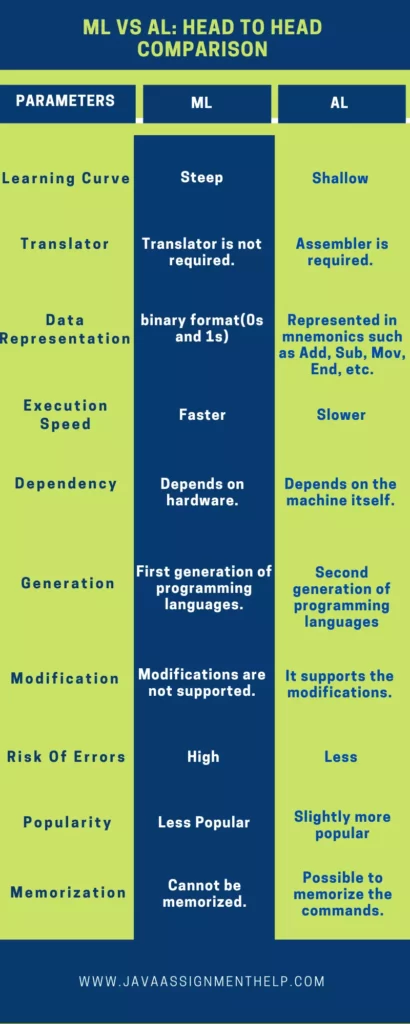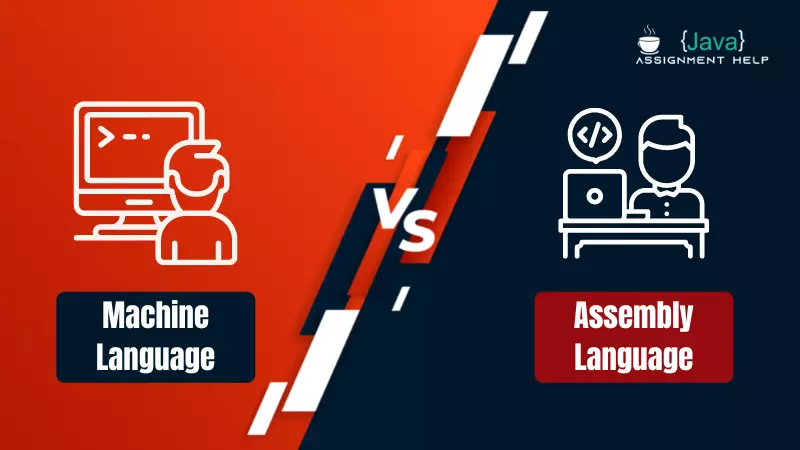There are different programming languages that programmers use to instruct computers. Two of such popular languages are Machine language and Assembly programming language.
Both these languages fall under the category of low-level computer programming languages. That’s why many students and beginners get confused about Machine language vs Assembly language. They think them the same technologies. But, they are not!
So, today in this blog, we will see all the major differences between Machine language and Assembly language in detail. So, let’s start our discussion!
What Is Machine Language?
Machine language is a low-level language that a computer can understand and is made up of binary integers or bits. It’s also called machine code or object code. Machine language is very difficult to understand for humans.
Machine language is the only language that the computer understands. All the programming languages including Assembly language must be converted to machine code so that the computer can understand the instructions.
Machine language is transmitted to the system processor when a given task, even the simplest operation. As computers are digital devices, they can only understand binary data(0 and !). All data on a computer, such as applications, videos, and photos, is encoded in binary.
Advantages of Machine language
- Best for small computers with limited memory.
- The translator is not required for the execution of programs. Therefore, execution speed is faster than any other programming language.
- Machine language programs are efficient as the execution time is short.
Disadvantages of Machine language
- Machine language programs are written in the form of zeros and ones, which are difficult to remember and prone to errors.
- The code is extremely difficult to read, so finding and correcting an error is also difficult.
- If you got any error in one statement, you have to correct the error and rewrite all of the following statements.
- You have to change the data and addresses of the instruction to conform with new programs to use the parts of previously written programs.
What Is Assembly Language?
Assembly language is a low-level programming language. It is a simpler alternative to machine language for programmers. Unline machine language, computers do not understand the Assembly language directly.
Assembly language uses an assembler that converts assembly code into machine code that a computer can understand. The assembler works like a translator between a computer and an Assembly language programmer.
Assembly language is used to understand instructions and pass them on to machine language for processing. It is primarily dependent on the computer’s architecture. Mnemonic processor instructions or data, as well as other statements or instructions, are all included in Assembly Language.
Note: If you have any pending Assembly language homework, you can ask for our Assembly language homework help service at a reasonable price and score A+ grades guaranteed.
Advantages of Assembly language:
- Assembly language is a low-level programming language. So, it is faster in speed and extremely optimized.
- Efficient use of memory.
- High-level hardware control.
- It can access memory and registers that cannot be accessed with high-level languages.
- No need for compilers for code optimization.
- Bugs are easy to identify and fix.
Disadvantages of Assembly language
- Difficult to write and maintain code.
- Many times the code is not portable to other Microprocessors or Microcontrollers.
- Algorithm design limits.
Machine Language vs Assembly Language Detailed Differences
Let’s look at some of the key differences between Machine language and Assembly language:

Translator
Machine language is a low-level language. Computers directly understand it. So, machine language does not require a translator to convert it to computer-understandable language.
Assembly language is also a low-level programming language. However, it requires an Assembler to convert it into computer understandable language.
Learning Curve
Assembly language is easier to learn. So, the learning curve is shallow. On the other hand, Machine language is a lot more complex than Assembly language. So, It has a steep learning curve.
Data Representation
We can represent machine language data only with the help of binary format(0s and 1s), hexadecimal, and octadecimal. At the same time, Assembly language data can be represented with mnemonics such as Add, Sub, Mov, End, etc.
Execution Speed
Machine language has the fastest execution speed in comparison to any other programming language. All the data in machine language is already present in computer understandable form.
On the other hand, Assembly language is slower in execution as the code must be converted to machine language before execution.

Dependency
Machine language depends on the hardware. At the same time, Assembly language depends on the machine itself. That’s why it is not portable.
Generation
Machine languages are the first generation of programming languages. On the other hand, Assembly languages are the second generation of programming languages.
Modification
The machine language does not support changes. But, Assembly language supports the modifications.
Risk Of Errors
As machine language is challenging to write and understand, there is a high risk of errors when coding in a machine language. On the other hand, coding in Assembly language is more straightforward, and the risk of errors is less.
Popularity
We can decide on Machine language Vs Assembly language popularity on the basis of the number of Google searches for both terms over the past few years. Below is the Google search trend graph for Machine language and Assembly language, depicting the past 5 years of worldwide searches.
Earlier, there was a significant difference between the popularity of Assembly and Machine language, but later this difference reduced, and now the popularity is almost similar. However, the Assembly language is slightly more popular than the machine language.
Machine Language vs Assembly Language: Head To Head Comparison
| Parameters | Machine Language | Assembly Language |
| Learning Curve | Steep | Shallow |
| Translator | Translator is not required. | Assembler is required to translate Assembly language into machine language. |
| Data Representation | Data is represented in binary format(0s and 1s) | Data is represented in mnemonics such as Add, Sub, Mov, End, etc. |
| Execution Speed | Faster | Slower |
| Dependency | Depends on hardware. | Depends on the machine itself. |
| Generation | First generation of programming languages. | Second generation of programming languages |
| Modification | Modifications are not supported. | It supports the modifications. |
| Risk Of Errors | High | Less |
| Popularity | Less Popular | Slightly more popular than Assembly language. |
| Memorization | Cannot be memorized. | Possible to memorize the commands. |
Conclusion
You have just finished reading the detailed information about machine language vs assembly language. Both these languages are extremely fast, efficient, and low levelo programming languages. So, its common for beginners to get confused between these two. Hopefully, after reading this blog, you have a clear picture of machine language vs assembly language in your mind.
Frequently Asked Questions
What are examples of machine language?
Examples of machine languages are binary digits(0 and 1s), hexadecimal, and octal decimal. Machine languages are directly understood by the computer and are difficult for humans.
What is assembly language used for?
An Assembly language is used to instruct a computer to perform a certain task. Assembly language is designed to be readable by humans. It requires an Assembler to convert Assembly language code into machine language code.

